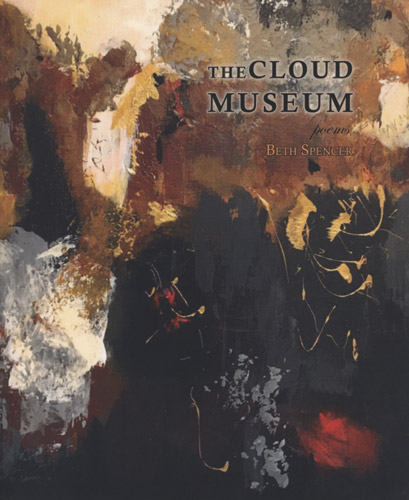The Cloud Museum
A figure named Alice dominates the initial section of Beth Spencer’s poetry book, The Cloud Museum. Is Alice real? You’ll have to judge for yourself. The second section of the book swirls around the definitely real artist Jay DeFeo.
A figure named Alice dominates the initial section of Beth Spencer’s poetry book, The Cloud Museum. Is Alice real? You’ll have to judge for yourself. The second section of the book swirls around the definitely real artist Jay DeFeo.
Spencer, who founded Bear Star Press, has published poetry and fiction literary magazines, but for her first book of poetry, she takes on two disparate figures in two entirely different ways. In the Alice poems, the phrasing is tantalizing and written in fairly standard free verse form as shown in “Alice Underground”:
Alice: a cathedral
of intersecting forces, a field
of crows flying the cross-
winds. Threateningsabotage, the thunderlings
have my sympathy for once, their crazed
harangue masking their fear
of losing her to the unknown.
We’re given more about Alice in “Rosemary”:
From the west some scrap of cloud,
like smoke or mist.
I count on these
since I cannot count on Alice.
Turning to the poems in the Jay Defeo section, we see they’re composed in the voice of Defeo, and Spencer omits punctuation and capitalization, a technique that calls for closer reading. She also includes occasional prose and experimental poems: one consists of layers of circular text.
Between the sections, I found the DeFeo poems to be the strongest. Unfamiliar with DeFeo, I did some research and discovered she lived from 1929 until 1989, and although she worked in numerous media, her most famous piece is the massive relief work The Rose. If you look it up—and you should to get the full impact of the poems—you won’t see a typical garden painting. It is unique in its immense weight and size. Various sources give estimates of weight ranging from 2,000 pounds to 2,300 pounds, and the finished project is approximately 8 feet x 11 feet, created from layer upon layer of oil paint, wood and mica.
In DeFeo’s voice, Spencer tosses in word play in “not endless”:
most days I did not walk the via negativa
but tripped the light monastic my rose
neither prim nor wild
attracting pilgrims who shared cigarettes and wine
and stared at her
while i added or scraped off layers
In the same poem, a bat enters DeFeo’s studio:
i imagined its mouth
on the lead-laced petals its small face
brushing the paint
it made me sad
it was as if i too were small before my fleur
not knowing where she planned to lead me
Spencer interprets more about the artist and her drive in “swinging as i always have”:
i was arrested once
for stealing paint lost my job
over two cans one red one black
kept it from my parents though
[ . . . ]
i made jewelry for a while out of oddments
used an ice pick and tweezers it sold well
but the imp was in my blood
saying go large again make something
of yourself
And Spencer displays DeFeo’s humor in “deathrose,” which starts out:
not throes my friends
don’t be so eager
to pitch me in the myth bin
for tortured artists
[ . . . ] it’s true i scraped that flower to death
at least four times
Notes at the end of the book add a welcome perspective to the DeFeo poems. For example, “Deathrose was DeFeo’s initial name for The Rose.” And the circular poem, titled “Color Wheel,” is referenced with this note: “The phrase in the innermost circle is loosely taken from Blake’s ‘If you have form’d a Circle to go into, go into it yourself & see how you would do.’”
The poem that wraps up the book is called “dream/rückenfigur,” Rückenfigur refers to a figure in art seen from behind. Spencer’s notes tell that the poem “recounts a dream DeFeo had toward the end of her life”:
we round a corner
and there it is my fleur
in a dark alcove lit from the sides
and this is the truth it is like seeing
her for the first time radiant
timeless perfectly restored
all the grime washed off
a few mica flecks glinting[ . . . ]
feeling a little cocky i approach my double
whisper into her hair you know
i did that
While I’m still unsure of the realness of Alice, Beth Spencer brought Jay DeFeo’s works alive for me. The body of poetry in The Cloud Museum aptly conveys why both Alice and DeFeo commanded Spencer’s attention.





